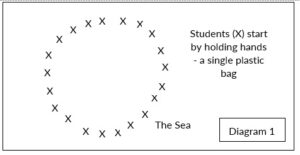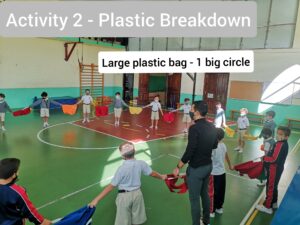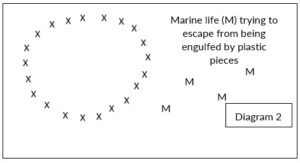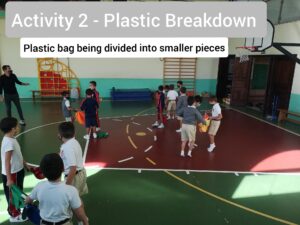BeMED 6. Plastic Breakdown
Title |
Plastic BreakdownActivity 2 of 3 about plastic pollution |
|
Author |
Saviour Bonnici |
|
Age Guide |
Year 1-8 |
|
Subject Area |
Physical Education |
|
| Preparation Time | 3 minutes | |
| Estimated Duration | 30 to 45 minutes | |
| Site | Gym/ Yard / Outdoor space | |
| No. of participants | Whole class | |
| Educational objectives | Through this interactive activity students learn how plastic breaks into microplastic. It is important for students to conceptualize the process of plastic breakdown, for them to act against the effects of micro-plastics.
Additionally, this is a great activity to work on teamwork and improve their physical abilities mostly by responding to quick stimulus, running and agility. |
|
| Learning Outcomes | – I am able to react to acoustic and visual stimuli through a change in speed while running, and at the same time changing direction quickly and effectively.
– I am able to understand that I am responsible for my actions and capable of anticipating the problems of consuming plastic and adapt to reduce it. |
|
| Link to SDGs
|
SDG 12: Responsible consumption
SDG 14: Life below water SDG 15: Life on Land |
|
| Remote preparation | Playing ‘Uncontrollable’ (lesson plan 5 in this resource pack) before this activity will help students to better conceptualize micro-plastics. But this is optional. | |
| Equipment needed | 4 Bibs
Internet connection is needed to watch the video links provided in the background information. |
|
| Method | Objective: Students must quickly react to form new groups otherwise they risk being left behind.
Part 1: Familiarize With The Game 1) A class of say 25 students, hold hands – representing a plastic bag floating in the sea, the playing area (Diagram 1). 2) The teacher calls out a smaller number. Students must quickly form new groups consisting of the mentioned number. This represents the plastic bag disintegrating into smaller pieces.
3) Smaller numbers are called in sequence, each time forming new groups until eventually the number 1 is called out and students are now single individuals – this is the micro-plastic. The single plastic bag problem has now multiplied into unmanageable micro-plastics. 4) The teacher explains about the process of plastic breakdown. Check the Recap section below for information. Part 2: Introducing Marine Life 5) Restart the game. 6) Same as part 1 but this time 4 students wearing a bib represent marine life. These will be roaming around the playing area (diagram 2). All the other students representing the plastic bag try to catch the marine life.
Being large the plastic will not be able to catch marine life at first. The situation turns when there are too many plastic pieces engulfing marine life. |
|
| Recap
|
When Part 1 is over the teacher explains about disintegration of plastic.
Environmental factors such as the sun and salt, breakdown the plastic bag into very small pieces which are impossible to collect. The video l
Teacher should explain that in reality micro-plastic does not catch fish, but the other way round. The more micro-plastics accumulate, the worse the situation for marine life becomes. There are billions of these micro-plastics circulating in the sea. If you go in any local beach you will certainly find small micro-plastics mixed into the sand. Marine life will not be able to differentiate between food and micro-plastics, ending up consuming it and cause great harm. In some localities around the world these particles, and all kind of human rubbish gather in huge amounts. It is calculated that in these places there is more plastic than marine life. |
|
| Follow-up activities | The previous activity – Uncontrollable (Lesson plan 5) – was an introduction to plastic pollution.
Next step is for students to experience how micro-plastics accumulate into the food chain and our bodies. The next follow-up lesson – Accumulation – will complete a series of 3 activities based around plastic pollution while engaging in physical activity. |
|
| Background information for educators | Video: Micro-plastics explained (explainity® explainer video)
https://www.youtube.com/watch?v=49OJoTsZYO0&t=23s (Provides a holistic analysis about plastic-breakdown.) |



 Rule: A catch is valid if the plastic group has the correct amount of members last called by the teacher. If for some reason the group splits while catching, this does not count.
Rule: A catch is valid if the plastic group has the correct amount of members last called by the teacher. If for some reason the group splits while catching, this does not count.


